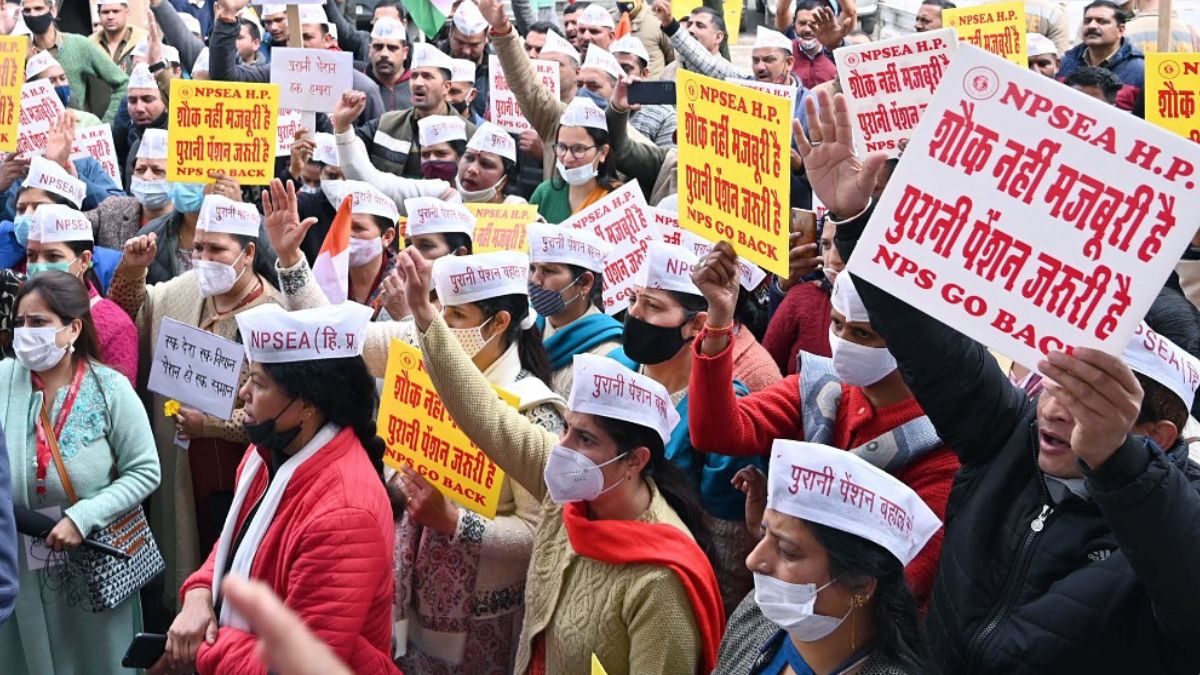
More and more states have vowed to return to the OPS. But a discord has arisen after the central government rejected the demand of the states to refund employees’ fund held under NPS
Several states are going back to the old pension scheme (OPS). States like Rajasthan, Chhattisgarh and Jharkhand have already implemented the old pension scheme while Punjab and Himachal Pradesh have announced plans to implement it. However, the big question is how much money is held under the National Pension System (NPS) which states are demanding but Centre has said no to it.
The Pension regulator, the Pension Fund Regulatory and Development Authority (PFRDA) has rejected demands made by Rajasthan, Chhattisgarh and Jharkhand to return funds deposited under the National Pension System, after these states reverted to the old pension scheme.
Union Finance Minister Nirmala Sitharaman, who was in Shimla recently, made it clear that “the money in the National Pension Scheme belongs to individual contributors and as per law, state governments cannot get it back”. Her junior, Bhagwat Karad. Union Minister of State for Finance, said the PFRDA has informed that there is no legal provision for a refund of NPS contributions.
Some opposition-governed states have vowed to return to the OPS, which offers 50% of the last pay drawn to government employees, instead of the NPS, where 10% of the salary is contributed by employees and a matching contribution is made by the employer. The money is then given to the designated fund managers. On retirement, the corpus is returned to the employee with the funds to be used to buy annuity covers.
According to the Ministry of Personnel, Public Grievances & Pensions, the National Pension System (NPS) was introduced for Central Government employees from 01.01.2004 vide Ministry of Finance (Department of Economic Affairs) Notification No. 5/7/2003-ECB & PR dated 22.12.2003 for all new recruits joining the Central Government service (except armed forces) from 01.01.2004. On introduction of the National Pension System, the Central Civil Services (Pension) Rules, 1972 were amended. Accordingly, the benefits of the old pension scheme under the Central Civil Services (Pension) Rules, 1972 are not admissible to the Central Government civil servants appointed on or after 01.01.2004, under the amended rules.

The ministry made it clear that there is no proposal to reintroduce the old pension scheme to Central Government civil employees joined on or after 01.01.2004 under consideration of the Government of India.
State-wise data
As per the data shared by the Finance Ministry, there are over 20 lakh Central Government NPS subscribers while more than 50 lakh State Government Employees have subscribed to the scheme. The total AUM under NPS (Central Government) is over Rs 2 lakh crores while the total AUM of state employees is more than Rs 3.5 lakh crore as of 31st October 2022.
In fact within a year of bringing NPS, almost all the big states implemented it at their level. Till February 28, 2022, more than 50 lakh employees of state governments were under NPS, while more than 22 lakh central employees are its beneficiaries. Implementation of old pensions will also increase the challenges for the states. Following is the detailed break-up of Central and state-wise corpus under NPS.
Total AUM of State Government Employees under NPS:
Error! Filename not specified.Source: PFRDA/Data shared by Ministry of Finance in Rajya Sabha
Total AUM of Central Government Employees under NPS
Error! Filename not specified.
Refund request from States
“The state governments of Rajasthan and Chhattisgarh along with the state government of Jharkhand have sent a proposal to the Central Government/PFRDA to return the accumulated corpus of subscribers under the National Pension System (NPS). However, no such proposal has been received from the state government of Punjab,” Dr Karad said.
“PFRDA has informed the respective state governments that there is no provision under Pension Fund Regulatory and Development Authority Act, 2013 read along with PFRDA (Exits and Withdrawals under the National Pension System) Regulations, 2015, and other relevant Regulations, as amended from time to time, vide which the funds, which are already deposited both in the form of Government contribution and Employees’ contribution towards NPS, along with accruals, can be refunded and deposited back to the State Government,” Dr Karad said.
The question arises as to why there is a clamour for old pension scheme and why has it become a major election issue:
Old pension scheme (OPS)
In the OPS, upon retirement, employees receive 50 percent of their last drawn basic pay plus dearness allowance or their average earnings in the last ten months of service, whichever is more advantageous to them. A ten-year service requirement should be met by the employee.
Under OPS, employees are not required to contribute to their pensions. An incentive for taking government employment was the guarantee of a pension post-retirement and a family pension. Retirement corpus building was not pressured. OPS has become unsustainable for governments due to the rise in life expectancy.
The General Provident Fund facility is available in the Old Pension Scheme.
No deduction will be made from a salary for pension.
A fixed pension is given after retirement, i.e. 50% of the last salary is received as a pension.
The entire amount of the pension is given by the government.
If a government employee dies while in service, then the family dependent will be entitled to the pension.
New pension scheme (NPS)
In the NPS, those employed by the government contribute 10 percent of their basic salary to NPS, while their employers contribute up to 14 percent. Private sector employees can also participate in the NPS voluntarily, although some rules have changed.
With NPS, the customer has much greater flexibility and has a greater sense of control over her fate. A professional pension fund manager can ensure that superior returns and a larger retirement corpus are achieved, regardless of equity or debt.
Additionally, No General Provident Fund (GPF) facility will be available under NPS. A certain amount will be deducted every month from the salary. But there is no guarantee of fixed pension after retirement
The amount of pension for the employee will depend on the stock market return. A pension insurance company will give in NPS after buying an annuity. The benefit of inflation and pay commission will not be available in NPS.
Among the challenges related to the old pension scheme are that there will be a big adverse impact on the state budget. The burden on the state governments will increase with an increase in life expectancy. The government was finding it increasingly difficult to pay pensions forcing them to opt for the NPS system. However, with clamour rising for restoration of the old pension scheme, there is no clarity on what will happen to the money deposited in NPS till now and whether the governments take back this money.












